Recent advances in digital video analysis and extraction have made video more accessible than ever. The representation and recognition of events in a video is important for a number of tasks such as video surveillance, video browsing and content based video indexing. Rawdata and low-level features alone are not sufficient to fulfill the user’s needs; that is, a deeper understanding of the content at thesemantic level is required. Currently, manual techniques, which are inefficient, subjective and costly in time and limit the queryingcapabilities.Here, we propose a semantic content extraction system that allows the user to query and retrieve objects, events, and concepts that areextracted automatically. We introduce an ontology-based fuzzy video semantic content model that uses spatial/temporal relations in event and concept definitions. This metaontology definition provides a wide-domain applicable rule construction standard that allowsthe user to construct ontology for a given domain. In addition to domain ontologies, we use additional rule definitions (without using ontology) to define some complex situations more effectively. The proposed framework has been fully implemented and tested on three different domains and it provides satisfactory results.
Keywords |
| Semantic content extraction, video content modeling, fuzziness, ontology |
INTRODUCTION |
| There is an increasing need to design efficient methods to semantically annotate video to store, retrieve and
manage the information captured in them. Such extractions would not only help human users to easily query and
manage their digital libraries, but also enable automated applications performing complicated tasks like video
surveillance to create, store, exchange and reason with the data. The ultimate goal is to enable users to retrieve some
desired content from massive amounts of video data in an efficient and semantically meaningful manner. |
| There are basically three levels of video content which are raw video data, low-level features and semantic
content.First, raw video data consist of elementary physical video units together with some general video attributes
such as format, length, and frame rate. Second, low-level features are characterized by audio, text, and visual
features such as texture, color distribution, shape, motion, etc. Third, semantic content contains high-level concepts
such as objects and events.These are the three levels of video content. |
| The first two levels on which content modeling and extraction approaches are based use automatically extracted
data, which represent the low-level content of a video, but they hardly provide semantics which is much more
appropriate for users. Users are mostly interested in querying and retrieving the video in terms of what the
video contains. Therefore, raw video data and low-level features alone are not sufficient to fulfill the user’s need;
that is, a deeper understanding of the information at the semantic level is required in many video- based
applications. |
| It is very difficult to extract semantic content directly from raw video data. This is because video is a
temporal sequence of frames without a direct relation to its semantic content. Therefore, many different
representations using different sets of data such as audio, visual features, objects, events, time, motion, and spatial
relations are partially or fully used to model and extract the semantic content. No matter which type of data set is
used, the process of extracting semantic content is complex and requires domain knowledge or user
interaction. |
| A simple representation could relate the events with their low- level features using shots from videos, without any
spatial or temporal relations. However, an effective use of spatiotemporal relations is crucial to achieve reliable
recognition of events. Employing domain ontologies facilitate use of applicable relations on a domain. There are no
studies using both spatial relations between objects, and temporal relations between events together in an
ontology-based model to support automatic semantic content extraction. |
| A Video Event Recognition Language (VERL) that allows users to define the events without interacting with
the lowlevel processing is defined. VERL is intended to be a language for representing events for the purpose
of designing an ontology of the domain, and, Video Event Markup Language (VEML) is used to manually
annotate VERL events in videos. The lack of low-level processing and using manual annotation are the drawbacks
of this study. In this study, a new Automatic Semantic Content Extraction Framework (ASCEF) for videos is
proposed for bridging the gap between low-level representative features and high-level semantic content in terms of
object, event, concept, spatial and temporal relation extraction. In order to address the modeling need for objects,
events and concepts during the extraction process, an wide-domain applicable ontology-based fuzzy VIdeo
Semantic Content Model (VISCOM) that uses objects and spatial/temporal relations in event and concept
definitions is developed. VISCOM is a metaontology for domain ontologies and provides a domain-independent
rule construction standard. |
| In the automatic event and concept extraction process, objects, events, domain ontologies, and rule definitions are
used. The extraction process starts with object extraction. Specifically, a semiautomatic Genetic Algorithm-based
object extraction approach is used for the object extraction and classification needs of this study. Then, objects
extracted from consecutive representative frames are processed to extract temporal relations, which is an important
step in the semantic content extraction process. In these steps, spatial and temporal relations among objects and
events are extracted automatically allowing and using the uncertainty in relation definitions. The organization of the
paper is as follows. In Section 2, the proposed video semantic content model is described in detail. The automatic
semantic content extraction system is explained in Section 3. In Section 4, the performed experiments and the
performance evaluation of the system are given. Finally, in Section 5, our conclusions and future research
directions are discussed. |
VIDEO SEMANTIC CONTENT MODEL |
| VISCOM is a well-defined metaontology for constructing domain ontologies. It is an alternative to the rule
based and domain-dependent extraction methods. Constructing rules for extraction is a tedious task and is not
scalable. Without any standard on rule construction, different domains can have different rules with
different syntax. In addition to the complexity of handling such difference, each rule structure can have
weaknesses. Besides, VISCOM provides a standardized rule construction ability with the help of its
metaontology. It eases the rule construction process and makes its use on larger video data possible. |
| The rules that can be constructed via VISCOM ontology can cover most of the event definitions for a wide
variety of domains. However, there can be some exceptional situations that the ontology definitions cannot cover.
To handle such cases, VISCOM provides an additional rulebased modeling capability without using ontology.
Hence, VISCOM provides a solution that is applicable on a wide variety of domain videos. Objects, events,
concepts, spatial and temporal relations are components of this generic ontology-based model. Similar generic
models such as which use objects and spatial and temporal relations for semantic content modeling neither use
ontology in content representation nor support automatic content extraction. To the best of our knowledge, there is
no domain-independent video semantic content model which uses both spatial and temporal relations between objects
and which also supports automatic semantic content extraction as our model does. |
| The starting point is identifying what video contains andwhich components can be used to model the video
content.Keyframes are the elementary video units which are still images, extracted from original video data
that best represent the content of shots in an abstract manner. Name,domain, frame rate, length, format are
examples of general video attributes which form the metadata of video. Both the ontology model and the semantic
contentextraction process is developed considering uncertainty issues. For the semantic content representation,
VISCOMontology introduces fuzzy classes and properties. Spatial Relation Component, Event Definition, Similarity, Object Composed Of Relation and Concept Component classes are fuzzy classes as they aim to having
fuzzy definitions. |
ONTOLOGY-BASED MODELING |
| VISCOM is developed on an ontology-based structure where semantic content types and relations between
these types are collected under VISCOM Classes, VISCOM Data Properties which associate classes with
constants and VISCOM Object Properties which are used to define relations between classes. In addition, there
are some domain independent class individuals.C-Logic is used for the formal representation of VISCOM
classes and operations of the semantic content extraction framework. C-Logic includes a representation
framework for entities, their attributes, and classes using identities, labels, and types. |
| VISCOM collects all of the semantic content under the class of Component. A component can have synonym
names and similarity relations with other components. Component class has three subclasses as Objects, Events, and
Concepts. Objects correspond to existential entities. An object is the starting point of the composition. An
object has a name, low-level features, and composed-of relations. Basketball player, referee, ball and hoop are
examples of objects for the basketball domain. |
| Events are long-term temporal objects and object relation changes. They are described by using objects and
spatial/ temporal relations between objects. Relations between events and objects and/or their attributes indicate
how events are inferred from objects and/or object attributes. Jump ball, rebound, and free throw are examples
of events for the basketball domain.Concepts are general definitions that contains related events and objects
in it. Each concept has a relation with its components that are used for its definition. Attack and defense are
examples of concepts for the basketball domain. |
| Besides, nearly every domain has a number of irregular situations that cannot be represented with the relation sets
defined in the ontology. VISCOM is enriched with additional rule definitions where it is hard to define
situations as a natural part of ontology. The second purpose of additional rules is to define such complex
situations. |
| Rules can contain any class/property individual defined in the ontology. In fact, VISCOM is adequate to
represent any kind of event definition in terms of spatial or/and temporal relations and similarity definitions.
Rules give the opportunity to make the event definitions which contain a set of events or other class individuals
defined in the domain ontology. |
| Spatial Change class is utilized to express spatial relation changes between objects or spatial movements of objects in order to model events. Spatial regions representing objects have spatial relations between each other.
These relations change in time. This information is utilized in event definitions. Temporal relations
between spatial changes are also used when more than one spatial change is needed for definition. This concept
is explained under Temporal Relations and Event Definition classes Spatial changes have an interval that is
designated by the spatial relation individuals used in their definitions. |
| Spatial relations are momentary situations but periods of spatial relations can be extracted from consecutive
frames. Whenever the temporal situation between Spatial Relation Component individuals defined in a Spatial
Change individual is satisfied, the Spatial Change individual is extracted and Spatial Relation Component
individuals’ periods are utilized to calculate the Spatial Change individual’s interval. According to the
meaning of the spatial change, periods of spatial relations should be included or discarded in the calculation of
spatial change intervals. |
| Second alternative to define a spatial change is using spatial movements. Spatial movements represent spatial
changes of single objects. This class is used to define movement types. It has five individuals as; moving to left,
moving to right, moving up, moving down, and stationary. Spatial Movement Component class is used to declare
object movement individuals. “Ball moves left” is an example of an individual of this class. Temporal relations
are used to order Spatial Changes or Events in Event Definitions. Allen’s temporal relationships are used to
express parallelism and mutual exclusion between components. |
| Temporal Event Component class is used to define temporal relations between Event individuals Temporal
Spatial Change Component class is used to define temporal relations between spatial changes in Event
definitions. For instance, the temporal relation after is used between Ball hits Hoop and Player jumps Spatial
Change individual in the definition of Rebound event An event can have several definitions where each definition
describes the event with a certainty degree. In other words, each event definition has a membership value for the
event it defines that denotes the clarity of description. Event definitions contain individuals of Spatial Change,
Spatial Relation Component or Temporal Spatial Change Component classes. |
AUTOMATIC SEMANTIC CONTENT EXTRACTION FRAMEWORK |
| The Automatic Semantic Content Extraction Framework is illustrated in Fig. The ultimate goal of ASCEF is to
extract all of the semantic content existing in video instances. In order to achieve this goal, the automatic semantic
content extraction framework. There are two main steps followed in the automatic semantic content extraction
process. |
| The first step is to extract and classify object instances from representative frames of shots of the video
instances. The second step is to extract events and concepts by using domain ontology and rule definitions. A set of
procedures is executed to extract semantically meaningful components in the automatic event and concept
extraction process. The first semantically meaningful components are spatial relation instances between object
instances. Then, the temporal relations are extracted by using changes in spatial relations. concepts are extracted
by using the spatial and temporal relations. |
a. OBJECT EXTRACTION |
| Object extraction is one of most crucial components in the framework, since the objects are used as the input for
the extraction process. However, the details of object extraction process is not presented in detail, considering that
the object extraction process is mostly in the scope of computer vision and image analysis techniques. It can be
argued that having a computer vision-based object extraction component prevents the framework being domain independent. However, object extraction techniques use training data to learn object definitions, which are usually
shape, color, and texture features. These definitions are mostly the same across different domains. |
b. SPATIAL RELATION EXTRACTION |
| Object instances are represented with the MBR. There can been object instance (as regions) represented with
R in a frame F. Every spatial relation extraction is stored as a Spatial Relation Component instance which contains
the frame number, object instances, type of the spatial relation, and a fuzzy membership value of the relation.Spatial
relations are fuzzy relations and membership values for each relation type can be calculated according to the
positions of objects relative to each other. Below, we explain how membership values for each of the distance,
topological, and positional relation categories are calculated. |
c. TEMPORAL RELATION EXTRACTION |
| In the framework, temporal relations are utilized in order to add temporality to sequence Spatial Change or
Events individuals in the definition of Event individuals. One of the well-known formalisms proposed for temporal
reasoning is Allen’s temporal interval algebra [24] which describes a temporal representation that takes the notion of
a temporal interval as primitive. Allen’s algebra is used to express parallelism and mutual exclusion between model
components of VISCOM. |
d. EVENT EXTRACTION |
| Event instances are extracted after a sequence of automatic extraction processes. Each extraction process
outputs instances of a semantic content type defined as an individual in the domain ontology. Algorithm 2
describes the whole event extraction process. In addition, relations between the extraction processes are illustrated. |
e. CONCEPT EXTRACTION |
| In the concept extraction process, Concept Component individuals and extracted object, event, and concept
instances are used. Concept Component individuals relate objects, events, and concepts with concepts. When an
object or event that is used in the definition of a concept is extracted, the related concept instance is automatically extracted with the relevance degree given in its definition. In addition, Similarity individuals are utilized in order to
extract more concepts from the extracted components. The last step in the concept extraction process is executing
concept rule definitions. Concept Extraction Algorithm given as Algorithm 3 simply describes the whole concept
extraction process. |
CONCLUSION |
| The primary aim of this research is to develop a framework for an automatic semantic content extraction
system for videos which can be utilized in various areas, such as surveillance, sport events, and news video
applications. The novel idea here is to utilize domain ontologies generated with a domain- independent ontologybased
semantic content metaontology model and a set of special rule definitions. Automatic semantic Content
Extraction Framework contributes in several ways to semantic video modeling and semantic content
extraction research areas. First of all, the semantic content extraction process is done automatically. In addition, a
generic ontology-based semantic metaontology model for videos (VISCOM) is proposed. Moreover, the
semantic content representation capability and extraction success are improved by adding fuzziness in class,
relation, and rule definitions. An automatic Genetic Algorithm-based object extraction method is integrated to the
propose system to capture semantic content. In every component of the framework, ontology-based modeling and
extraction capabilities are used. The test results clearly show the success of the developed system. |
| |
Figures at a glance |
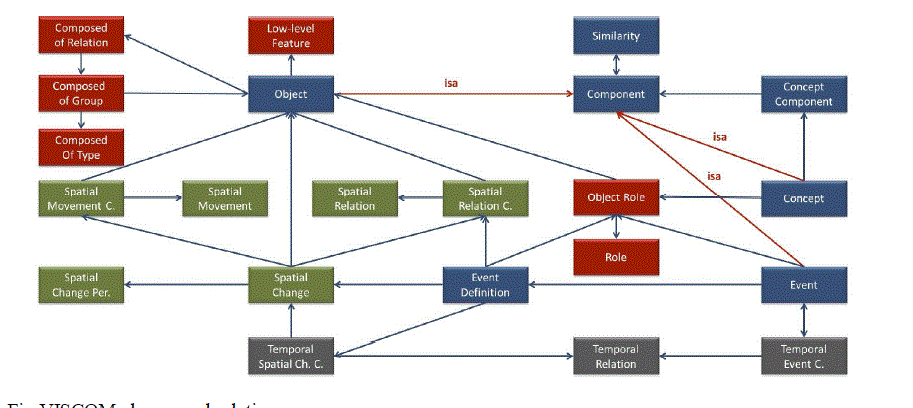 |
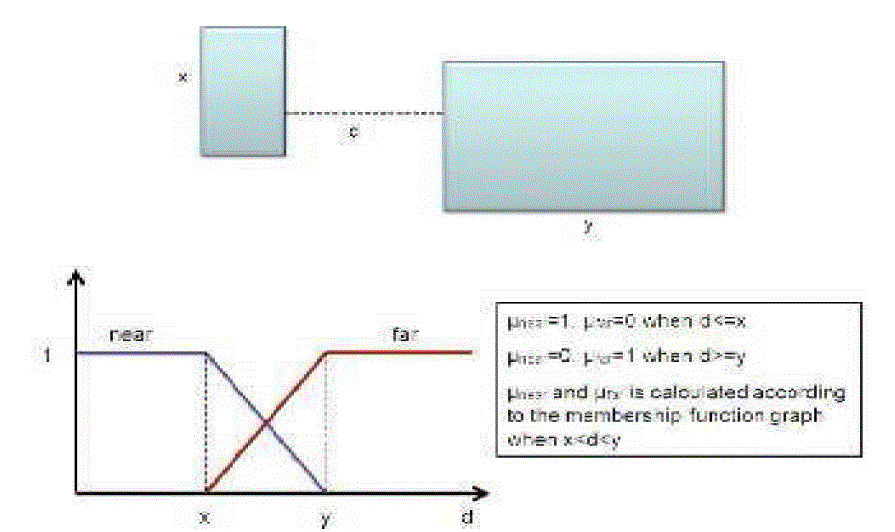 |
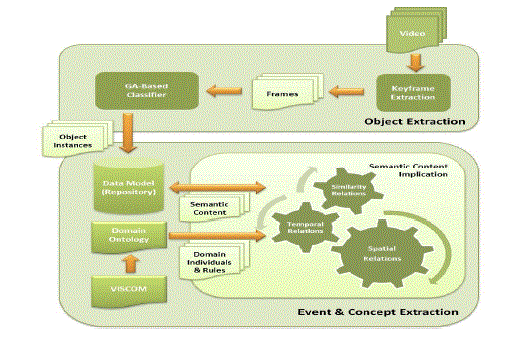 |
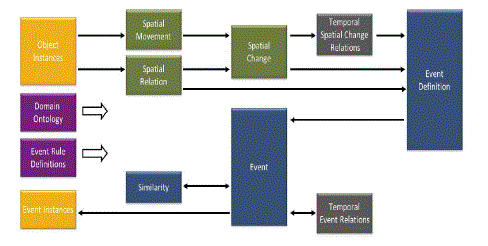 |
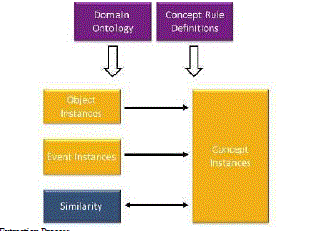 |
| Figure 1 |
Figure 2 |
Figure 3 |
Figure 4 |
Figure 5 |
|
| |
References |
- M. Petkovic and W. Jonker, “An Overview of Data Models and Query Languages for Content-Based Video Retrieval,” Proc. Int’l Conf. Advances in Infrastructure for E-Business, Science, and Education on the Internet, Aug. 2000.
- M. Petkovic and W. Jonker, “Content-Based Video Retrieval by Integrating Spatio-Temporal and Stochastic Recognition of Events,” Proc. IEEE Int’l Workshop Detection and Recognition of Events in Video, pp. 75-82, 2001.
- L.S. Davis, S. Fejes, D. Harwood, Y. Yacoob, I. Haratoglu, and M.J. Black, “Visual Surveillance of Human Activity,” Proc. Third Asian Conf. Computer Vision (ACCV), vol. 2, pp. 267-274, 1998.
- G.G. Medioni, I. Cohen, F. Bre´mond, S. Hongeng, and R. Nevatia, “Event Detection and Analysis from Video Streams,” IEEE Trans. Pattern Analysis Machine Intelligence, vol. 23, no. 8, pp. 873-889, Aug. 2001.
- S. Hongeng, R. Nevatia, and F. Bre´mond, “Video-Based Event Recognition: Activity Representation and Probabilistic Recognition Methods,” Computer Vision and Image Understanding, vol. 96, no. 2, pp. 129-162, 2004.
- A. Hakeem and M. Shah, “Multiple Agent Event Detection and Representation in Videos,” Proc. 20th Nat’l Conf. Artificial Intelligence (AAAI), pp. 89-94, 2005.
- M.E. Do¨nderler, E. Saykol, U. Arslan, O ¨ .Ulusoy, and U. Gu¨du¨ kbay, “Bilvideo: Design and Implementation of a Video Database Management System,” Multimedia Tools Applications, vol. 27, no. 1, pp. 79-104, 2005.
- T. Sevilmis, M. Bastan, U. Gu¨du¨ kbay, and O ¨ .Ulusoy, “Automatic Detection of Salient Objects and Spatial Relations in Videos for a Video Database System,” Image Vision Computing, vol. 26, no. 10, pp. 1384-1396, 2008.
- M. Ko¨pru¨ lu¨, N.K. Cicekli, and A. Yazici, “Spatio-Temporal Querying in Video Databases,” Information Sciences, vol. 160, nos. 1-4, pp. 131-152, 2004.
- Y. Zhang, C. Xu, Y. Rui, J. Wang, and H. Lu, “Semantic Event Extraction from Basketball Games Using Multi-Modal Analysis,” Proc. IEEE Int’l Conf. Multimedia and Expo (ICME ’07), pp. 21902193, 2007.
|